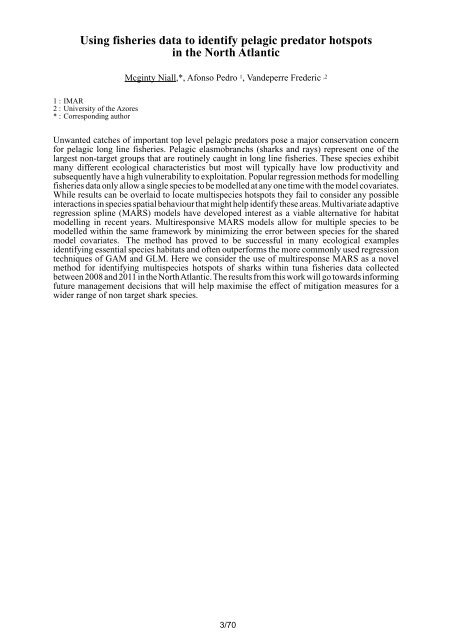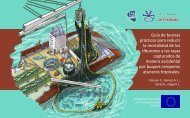Create successful ePaper yourself
Turn your PDF publications into a flip-book with our unique Google optimized e-Paper software.
Using fisheries data to identify pelagic predator hotspots<br />
in the North Atlantic<br />
1 : IMAR<br />
2 : University <strong>of</strong> the Azores<br />
* : Corresponding author<br />
Mcginty Niall,*, Afonso Pedro 1, Vandeperre Frederic ,2<br />
Unwanted catches <strong>of</strong> important top level pelagic predators pose a major conservation concern<br />
for pelagic long line fisheries. Pelagic elasmobranchs (sharks and rays) represent one <strong>of</strong> the<br />
largest non-target groups that are routinely caught in long line fisheries. These species exhibit<br />
many different ecological characteristics but most will typically have low productivity and<br />
subsequently have a high vulnerability to exploitation. Popular regression methods for modelling<br />
fisheries data only allow a single species to be modelled at any one time with the model covariates.<br />
While results can be overlaid to locate multispecies hotspots they fail to consider any possible<br />
interactions in species spatial behaviour that might help identify these areas. Multivariate adaptive<br />
regression spline (MARS) models have developed interest as a viable alternative for habitat<br />
modelling in recent years. Multiresponsive MARS models allow for multiple species to be<br />
modelled within the same framework by minimizing the error between species for the shared<br />
model covariates. The method has proved to be successful in many ecological examples<br />
identifying essential species habitats and <strong>of</strong>ten outperforms the more commonly used regression<br />
techniques <strong>of</strong> GAM and GLM. Here we consider the use <strong>of</strong> multiresponse MARS as a novel<br />
method for identifying multispecies hotspots <strong>of</strong> sharks within tuna fisheries data collected<br />
between 2008 and 2011 in the North Atlantic. The results from this work will go towards informing<br />
future management decisions that will help maximise the effect <strong>of</strong> mitigation measures for a<br />
wider range <strong>of</strong> non target shark species.<br />
3/70




